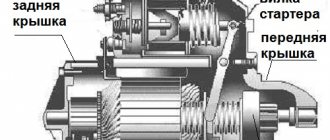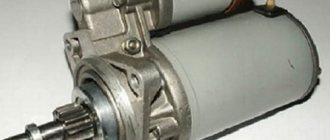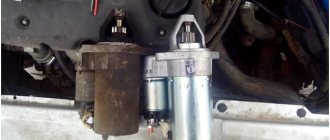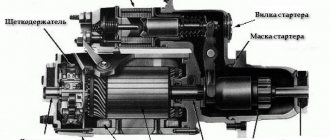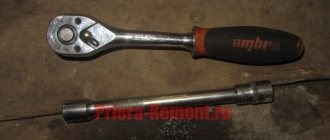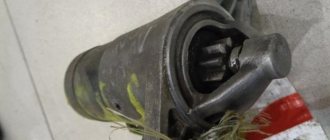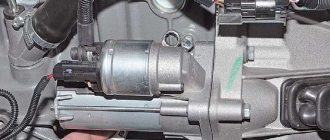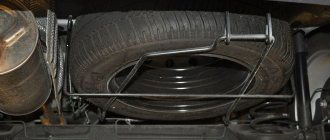A starter or starting device (PU), as it is sometimes called among motorists, is designed to start a car engine. After turning the key in the ignition switch, current is transferred from the battery to the control unit. The latter is activated, driving the motor.
Violation of the rules for using the mechanism leads to its rapid wear and damage. For example, keeping it in an active state for more than 15 seconds wears out the bendix teeth and increases the operating temperature on the rubbing surfaces.
The design of the starting device is quite complex, despite the intuitive operating principle. We do not recommend carrying out repairs without experience in servicing equipment.
How to remove the starter of a Lada Largus car
Place the car on a lift or inspection hole.
Disconnect the negative terminal of the battery.
Using a flat-head screwdriver, press the fasteners and remove the casing (if installed) of the electronic control unit (ECM).
Using a 10mm wrench, unscrew the two nuts 1 securing the expansion tank 2.
We remove and move the expansion tank to the side without disconnecting the hoses.
If a JR5 gearbox is installed, use a flat screwdriver to disconnect joints 1, selector and shift cables from the gearbox.
We press the clamps and disconnect the stoppers of the sheaths of the gear selection and shift cables from the gearbox bracket.
If JH3 gearbox is installed:
Remove the cover 1 of the gearshift drive rod joint. Using a 10mm wrench, unscrew bolt 2 securing the gearshift drive rod, remove the spacer bushing and disconnect the rod.
Using a 13mm head, unscrew the three bolts 1 securing the starter
If the car is installed on a lift, then we lift the car to perform work from below.
Using a 13mm socket, unscrew nut 2 securing bracket 4 to intake manifold 3.
Using a 17mm head, unscrew bolt 6 securing bracket 4 to cylinder block 5.
Remove bracket 4 for fastening intake manifold 3.
Use a 10mm socket to unscrew nut 2
Disconnect harness 1 of the ignition system wires from starter 3
Using a 10mm socket, unscrew nut 4 securing the starter wires 5.
Disconnect the starter wire.
Using a socket 8, unscrew nut 3 securing the starter electromagnetic relay wire 5
Starter installation
Install the starter in the reverse order of removal.
In this case, the tightening torques of threaded connections:
— starter mounting bolt — 44 Nm (4.4 kgf.m);
— starter wire fastening nut — 8 Nm (0.8 kgf.m);
— nut securing the starter electromagnetic relay wire — 5 Nm (0.5 kgf.m);
— bolt for fastening the gearshift drive rod — 27.5 Nm (2.75 kgf.m).
We connect the terminals to the battery.
Source
The internal combustion engine does not start when the starter is working
If in the ignition key position “Engine Start” the starter turns, but the engine does not start, it is necessary to find out the functionality of a number of elements.
| Diagnostics | Malfunction | Elimination procedure |
| The rotation of the internal combustion engine occurs more slowly than usual, and there are extraneous sounds in the engine compartment. | At low temperatures, engine oil may solidify. Wedging of engine attachments - water pump, generator. Destruction of the connecting rod and piston group elements - scuffing on the liners or cylinders. | Park the car in a warm place to allow the oil to warm up. Poor quality oil - replace. |
| Replace the generator/water pump or eliminate any jamming. | ||
| Repair the internal combustion engine. | ||
| Fuel tank arrow in empty position | Running out of fuel | Refuel the car |
| When the key is turned to the “ignition” position, the fuel pump is not heard to operate. | There is no power supply to the pump. | Remove the fuel pump, apply voltage to the terminals; if the pump works, check the power supply circuit (fuse, relay, wiring), as well as the security alarm. |
| The pump has failed. | Replace the inoperative pump with a new one. | |
| The engine can be started with the gas pedal pressed; after releasing it, the engine stalls. | The idle speed control sensor is faulty. | Install a new sensor |
| The engine tries to start jerkily, popping sounds are heard in the exhaust system, high vibration | There is no spark, sparking occurs at the wrong time. | Check for spark. Check the correct connection of high-voltage wires or ignition coils according to the electrical diagram. |
| Check the crankshaft position sensor and replace if necessary. | ||
| Insufficient pressure in the fuel rail. | Fuel pump wear. | Replace the pump. |
| Clogged fuel filter. | Replace the filter. | |
| Damaged fuel line. | Inspect the fuel line for kinks and other damage. | |
| During the cold season, water in the fuel system may freeze. | Heat the frozen line to above-zero temperature. | |
| Fuel injectors do not deliver gasoline | Faulty injector, problems in the electrical circuit. | Measure the injector resistance, it should be 12 ohms. Replace the faulty injector. |
| Check electrical wiring. | ||
| Engine control unit does not work | There is no 12V power supply to the ECU. | Check the power supply to the control unit. |
| ECU failure | Replace block. | |
| Air leak in the intake manifold. | Damage to the intake manifold. | Replace or repair the collector. |
| Damage to vacuum hoses. | Replace hoses or tighten clamps. | |
| Violation of the tightness of the intake tract | Change the intake manifold gaskets. |
After this, check that all marks on the belt, rollers and pulleys match. A broken timing belt can be checked in a simpler and faster way. Unscrew the oil filler cap on the engine, make sure that when you try to start the internal combustion engine, the camshaft rotates, part of it is visible under the cap.
This is interesting: Fuses for VAZ 2110: where are they located, replacement
Removing and checking the Lada Largus starter
We remove the starter to repair or replace it, as well as when dismantling the engine and gearbox.
We carry out the work on an inspection ditch or overpass.
We show the operations for removing the starter on a car with an engine
1.6 (16V). By car with engine
1.6 (8V) starter is removed in the same way. Disconnect the wire terminal from the negative terminal of the battery.
We remove the power unit protection (see “Removing the power unit protection”, p. 235).
Using a high “8” socket, unscrew the nut (the nut is attached to the tip of the wire).
Use a 13mm socket (without an extension) to unscrew the lower starter mounting bolt.
Use a screwdriver to move the drive gear along the shaft.
The gear should move easily along the shaft without jamming. If the gear sticks on the shaft, the drive must be replaced.
To check the starter, we connect the “positive” terminal of the battery to the upper contact bolt of the traction relay with wires for “lighting”, and the “negative” terminal to the starter housing.
How to remove the starter on LADA cars with your own hands
The starter is removed in connection with its replacement, inspection or repair. On LADA cars, the starter is installed on the clutch housing at the front in the direction of travel. Before starting work, you should disconnect the negative terminal of the battery, drive the car onto an inspection ditch (overpass) and remove the engine protection.
On all modern LADA cars (Lada XRAY, Vesta, Largus, Granta, Kalina, Priora and Niva 4x4), removing the starter is performed in the same way. Installation is carried out in reverse order. Distinctive features of the process are presented below.
Recommendations for starter maintenance
Adhere to the technical inspection schedules established by the manufacturer - every 15,000 km. Buy original parts and components at official points of sale.
Use the services of certified workshops for diagnostics and repairs. Remember that unprofessional intervention in the operation of the car is more likely to harm than help.
Don't skimp on consumables. Check the catalog numbers with the actual data specified in the instruction manual.
Keep the control unit active while starting the engine for no longer than 15 seconds, then 30 seconds. break. After starting the engine, release the key from the ignition switch as soon as possible. Excessive retention eats up the teeth on the drive shaft and flywheel.
Lada XRAY and Vesta
Remove the engine splash guard (instructions for Lada Vesta, XRAY).
For configurations with manual transmission: Unscrew 2 bolts (No. 1) and remove the clutch hydraulic cylinder (No. 2), without disconnecting it from the hydraulic actuator tube (No. 3). Hang the cylinder on the technological hook (head “13”).
For all configurations: Unscrew the nut (No. 1) and disconnect the terminal (No. 2) and the block with wires (No. 3) from the starter traction (retractor) relay (No. 4) (head “13”).
Remove 3 bolts (No. 1), remove the clutch hydraulic cylinder mounting bracket (No. 2) (for vehicles with manual transmission) and the starter (No. 3) (Torx E10).
Frequent malfunctions
The Lada Largus starter has certain malfunctions.
- Oxidation or loosening of the lower bolt of the solenoid relay. This instantly affects the engine starting - at first it is possible to start only after 2-3 attempts, then it does not work at all. Naturally, such fastening is not reliable - it is a bad contact at the starter terminal. You can repair it from under the car. In this case, you have to remove the right wheel and use an extension cord with a 12mm socket. It will be very difficult, but this is the only method to restore contact without dismantling a large number of parts as when removing the starter. It’s easier to work with two people - an assistant will guide the tool from above, from the engine compartment.
Lada Largus
Remove the cover (if equipped) of the electronic control unit (ECM) by releasing the two fasteners (flat-head screwdriver). Unscrew the 2 nuts (No. 1) securing the expansion tank (No. 2) (10mm wrench). Remove and move the expansion tank to the side without disconnecting the hoses.
For configurations with JR5 gearbox:
- disconnect the hinges (No. 1) of the gear selection and shift cables from the gearbox (flat-head screwdriver);
- press the clamps on both sides and disconnect the stoppers of the sheaths of the selection and shift cables from the gearbox bracket.
For configurations with JH3 gearbox:
- remove the cover (No. 1) of the gearshift drive rod joint;
- Unscrew the bolt (No. 2) securing the gear shift rod, remove the spacer sleeve and disconnect the rod (10mm wrench).
Unscrew the 3 bolts (No. 1) securing the starter (head “13”).
Raise the car and unscrew the nut (No. 2) securing the bracket (No. 4) to the intake manifold (No. 3) (head “13”). Unscrew the bolt (No. 6) securing the bracket (No. 4) to the cylinder block (No. 5) (head “17”). Remove the bracket (No. 4) that mounts the intake manifold (No. 3).
Tips to make diagnosis and repair easier
To diagnose a malfunction in a Lada Largus car, you may need special tools and devices. If there are problems with the fuel supply, it is necessary to measure the pressure in the fuel rail; for this you will need a special pressure gauge with an adapter. If it is missing, you can unscrew the gasoline supply hose from the rack, lower it into an empty container, turn on the ignition and measure how many liters of fuel the pump will pump in one minute. A working Lada Largus pump pumps approximately one and a half liters of fuel in one minute.
The performance of the crankshaft position sensor can be checked using an ohmmeter - a device that shows electrical resistance. The working sensor has a resistance of about 250 Ohms, and when a piece of metal approaches the sensor, this value should change.
The presence of a spark can be easily checked by removing the high-voltage wire or ignition coil from the spark plug and bringing the contact closer to a distance of 2-3 mm to the iron element of the engine. When starting the internal combustion engine, an electric charge - a spark - will jump between the wire/coil and the motor element. During the procedure, you must use special insulating gloves or tools.
Lada Granta, Kalina, Priora
Remove the protective cap (No. 3), unscrew the nut securing the wire to the starter solenoid relay (No. 4) and disconnect the wire from the relay (head “13”). Disconnect the block with wires (No. 2) from the starter solenoid relay.
For cars with a manual transmission with a traction drive: unscrew the 3 nuts securing the starter (No. 5) and remove it (head “13”).
For cars with automatic transmission and manual transmission with cable drive: unscrew three bolts (No. 5) and remove the starter (No. 3) (head “13” or Torx E14).
Alternative ways to start the engine
You can start a car with problems in the starter/ignition switch system by towing or using a pusher. To do this, you need to turn on the ignition, depress the clutch with the gearbox in second gear, accelerate the car to a speed of 10-15 km/h and release the clutch. If the engine starts, turn off the gear and stop smoothly.
There are situations when it is not possible to push the car to the required speed. In this situation, if the problem is not in the starter winding or jamming of its elements, you can start the car simply by short-circuiting the contacts with a screwdriver or a large wrench. To do this, you need to turn on the ignition and turn off the gearbox. Next, find the starter under the hood, remove the protective rubber casing from the wires and close two large opposite contacts. After the engine starts, open the indicated contacts.
Such actions must be carried out after making sure of your own safety and the safety of others.
Lada 4×4
Remove the rear support bracket for the intake pipe by unscrewing the two bolts with a 13mm wrench.
We remove the starter protective shield by unscrewing its fastening nuts with a “13” wrench.
From the bottom of the car, unscrew the two bolts securing the starter. From the engine compartment side, move the starter forward and disconnect the block with wires.
We unscrew the nut and disconnect the wire tip from the contact bolt of the traction relay. Remove the starter from the engine compartment.
By the way, do you know that the ignition system of LADA cars can be improved, for example, by abandoning the ignition key in favor of a start/stop button.
Share on social networks:
Found an error? Select it and press Ctrl+Enter..
Source
Originals, analogues, articles and prices
| Name / article / OEM | Price, rub.) |
| LADA Largus 8 cl Romania Original 8200815083 | From 9650 |
| LADA Largus 16 valves 8200266777 | From 6750 |
| LADA Largus engine .16 valves K4M Valleo 233009141R | From 9100 |
*check the price with your official representative at the time of purchase.
Common signs of unstable performance
- The control unit starts on the second or third attempt: the contact board of the traction relay burns out;
- The starter rotates with great effort: wear of the brushes and pressure spring;
- The drive shaft disengages due to some delay: wear of the bendix and flywheel teeth.
Where is the starter installed in a Lada Largus car?
As in many models of the Lada family, the control unit is located in the engine compartment, closer to the flywheel, at the end of the cylinder block wall.
